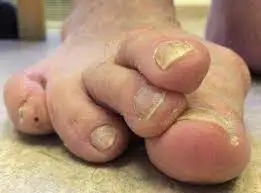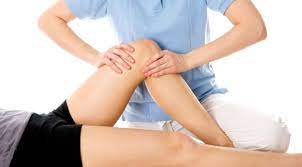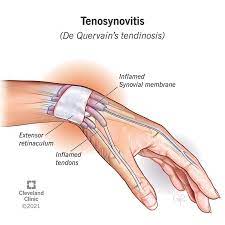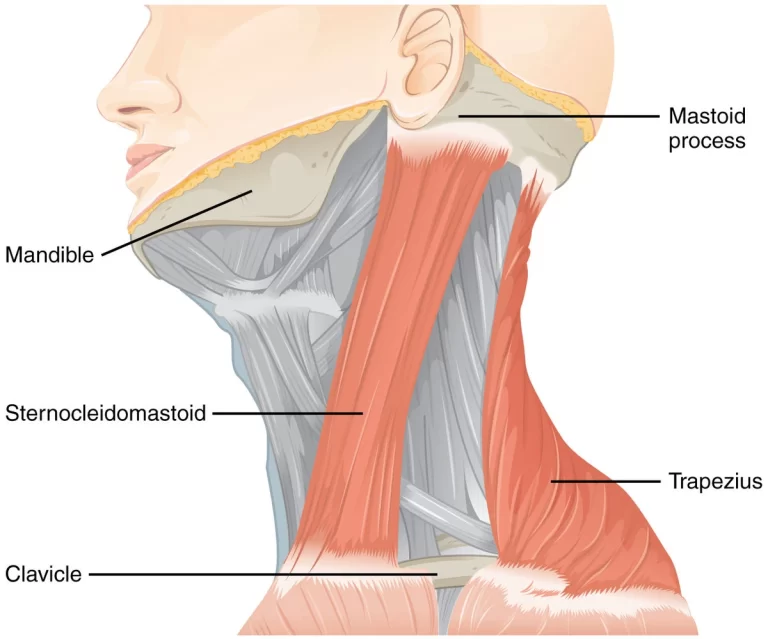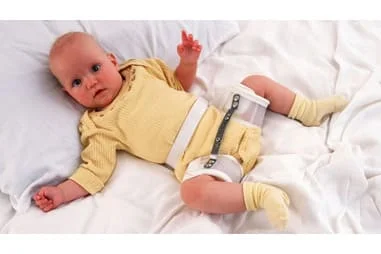Crossover Toes
Table of Contents
What is a Crossover Toes?
Crossover toes, also known as “crossed toes” or “toe crossover,” is a condition that affects the alignment of the toes in the foot. This condition occurs when one or more toes deviate and cross over the adjacent toe, often leading to discomfort, pain, and difficulty in wearing regular footwear.
Crossover toes can be a result of various factors, including genetics, improper footwear, or underlying foot deformities. In this introduction, we will explore the causes, symptoms, and potential treatment options for crossover toes, shedding light on this common foot ailment and its impact on individuals’ daily lives.
Description
The crossover second toe deformity happens when the lateral collateral ligament and joint capsule of the 2nd metatarsophalangeal joint deteriorate. The 2nd toe initially deviates in a medial direction but with time deviates dorsally and crosses up and over the great toe.
Anatomy of crossover toes
Toes are the integers of the foot of a tetrapod. Animal species like cats that walk on their toes are described as being digitigrade. Humans, and other creatures that walk on the soles of their feet, are defined as being plantigrade; unguligrade creatures are those that walk on hooves at the tips of their toes.
Structure
The toes are, from medial to lateral:
- The 1st toe also called the hallux (“big toe”, “great toe”, “thumb toe”), the innermost toe;
- The 2nd toe, (“index toe”, “pointer toe”),
- The 3rd toe, (“middle toe”);
- The 4th toe, (“fore toe”)
- The 5th toe, (“baby toe”, ), is the outermost toe.
Muscles
- Toe motions are usually flexion and extension (motion toward the sole or the back of the foot, resp.) through muscular tendons that join to the toes on the anterior and superior surfaces of the phalanx bones.
- With the exception of the hallux, toe motion is usually governed by the action of the flexor digitorum brevis and extensor digitorum brevis muscles.
- These join to the sides of the bones, making it impossible to move separate toes independently.
- Muscles in the middle of the toes on their top and bottom also assist in abducting and adducting the toes. The hallux and little toe have unique muscles:
- The hallux is initially flexed by the flexor hallucis longus muscle, situated in the deep posterior of the lower leg, through the flexor hallucis longus tendon.
- Additional flexion control is given by the flexor hallucis brevis.
- It is opened by the abductor hallucis muscle and the adductor hallucis muscle
- The little toe has a different set of control muscles and tendon attachments, the flexor and abductor digiti minimi.
- Too many other foot muscles contribute to fine motor control of the foot.
- The connective tendons in the middle of the minor toes account for the inability to actuate individual toes.
Blood supply
The toes take blood from the digital branches of the plantar metatarsal arteries and drain blood into the dorsal venous arch of the foot.
Nerve supply
- The sensation of the skin of the toes is given by nerves. The superficial fibular nerve supplies sensation to the top of the toes, except in the middle of the hallux and 2nd toe, which is supplied through the deep fibular nerve, and the outer surface of the third toe, supplied by the sural nerve.
- Sensation to the bottom of the toes is given by the medial plantar nerve, which supplies sensation to the great toe and inner 3 and-a-half toes, and the lateral plantar nerve, which gives sensation to the little toe and half of the sensation of the fourth toe.
- In humans, the hallux is generally longer than the 2nd toe, but in some individuals, it can not be the longest toe.
- There is an inherited trait in humans, where the dominant gene causes a longer second toe (“Morton’s toe” or “Greek foot”) while the homozygous genotype presents with the more usual trait: a longer hallux.
- Individuals with infrequent genetic disease fibrodysplasia ossificans progressiva characteristically have a short hallux that appears to turn inward, or medially, in relation to the foot.
Variation
- Humans generally have 5 toes on each foot.
- When more than 5 toes are present, this is identified as polydactyly.
- Other variants can involve syndactyly or arachnodactyly.
- Forefoot shape, incorporating toe shape, exhibits significant variation among individuals; these differences may be measured and have been statistically correlated with ethnicity.
- Such deviations can affect comfort and fit for various shoe types.
Function
- The human foot is made up of multiple bones and soft tissues that support the weight of the upright human.
- Especially, the toes help the human while walking, providing balance, weight-bearing, and thrust during gait.
Fast facts about overlapping toes
- About seven percent of individuals have an overlapping toe, according to a 2017 study.
- Approx 2.8 percent of newborns have an overlapping toe.
- In 20 to 30 percent of cases, an overlapping toe happens on the bilateral side.
- An overlapping toe happens equally in men and women.
Causes of overlapping toes in adults
- Overlapping toes can be inherited or can result from the footwear or the biomechanics of how you walk.
- An overlapping toe can be connected with more than one cause.
- Below given are some of the most typical causes for adults.
Heredity
A person can be born with an overlapping toe. A person also can inherit a bone structure in the foot that later leads to an overlapping toe. A longer 2nd toe, a condition called Morton’s toe, is thought to be connected with overlapping toes.
Tight-fitting shoes
If the shoes are too tiny or too tight in the toe box, it may force the little toe out of line. Wearing high heels or pointy-toe shoes may slowly cause a toe to overlap.
Arthritis
Arthritis may cause joint inflammation and stiffness in the feet that can change the alignment of the toes. Rheumatoid arthritis, for example, may change the foot structure and outcome in a bunion and big toe overlapping.
Biomechanics
The posture and the way a person walks may affect the feet and toes.
According to research, the foot rolling inward too much when a person walks, known as overpronation, is connected with the development of bunions and overlapping toes. Also, having a tight calf muscle may put pressure on the ball of the foot and contribute to a bunion and overlapping toe.
Foot conditions
Bunion- Situated at the base of the big toe, a bunion may push the big toe over onto the 2nd toe.
Flat feet- A lack of foot arch is connected with an improved risk of developing an overlapping toe. A person may inherit flat feet, or they can develop over time.
Hammer toe– With a hammer toe, the toe flexes down instead of pointing straight forward, which can cause the toe to overlap. A hammer toe can outcome from a bunion.
High arches– Either inherited or the outcome of a medical condition, high arches may tend to a hammer toe and overlapping toe.
Other factors
Age- As a person grows older, the feet tend to flatten or roll inward. This may lead to several foot issues, involving overlapping toes.
Injury- A foot injury can affect the joints in the toes.
Causes of overlapping toes in newborns
- A tiny percentage of newborns are born with an overlapping toe. generally, it’s a small toe that overlaps the 4th toe.
- Boys and girls are equally affected.
- It is believed that an overlapping toe is inherited.
- In a few cases, the baby’s position in the womb can crowd the toes, causing the tiny fingers to overlap.
- About 25 percent of infants born with an overlapping toe spontaneously heal with no treatment.
What are the symptoms of crossover toe?
If a person has crossover toe, a person will likely experience:
- Constant pain in the ball of the feet
- Swelling at the base of the 2nd toe
- Sores on the upper of the crossed-over toe
- A feeling that something is stuck inside the ball of the foot or on the shoe’s footbed
- Pain that worsens when walking
- Pain that worsens when the ball of the foot is squeezed together, like when wearing tight or pointy-toed shoes
- A person can be more likely to develop a crossover toe if a person has symptoms of another toe condition like a bunion or big toe joint arthritis (hallux rigidus).
What are the risk factors for crossover toe?
Foot anatomy – A few structural abnormalities like a flat foot, tight calf muscles, and a 2nd toe that’s longer than the big toe may make a person more prone to developing a crossover toe because of the additional stress exerted on the 2nd toe joint
Foot conditions – crossover toe usually happens with other conditions of the toe involving bunions and big toe joint arthritis (hallux rigidus)
Toe injuries – significant or repeated injuries to the 2nd toe involving fractures and stubbing the toe may damage the ligaments near the joint and lead to crossover toe
Treatment options for newborns
In most cases, conservative measures may successfully correct a newborn’s overlapping toe.
Simply taping the toe is generally adequate. A study of 44 newborns with an overlapping toe found that 94 percent increased or were cured after six months by simply taping the toes in a straight position.
Gentle stretching and toe spacers have been found to be an effective way of correcting an overlapping toe in a newborn.
Start treatment early-According to research, it is best to begin treatment for an overlapping toe before a child begins to walk. Otherwise, the toe can become rigid and require corrective surgery.
Treatment for overlapping toes in adults
Make sure to follow up with the doctor or a foot specialist if the toe is causing pain. The earlier a person treats their overlapping toe, the better the outcome will likely be.
Conservative measures are generally the 1st step to decrease pain and discomfort from an overlapping toe. If these do not work, your physician can suggest surgery.
Conservative measures
Be sure your shoes fit properly- The 1st step in relieving foot pain is to wear comfortable shoes with a wide-toe box. Try to discover a specialty shoe store with a trained fitter who may assist in finding the right size and fit. A person may also bring the shoe selection to the foot doctor to help figure out which shoes work and which don’t.
Use toe separators- A person may purchase these at most drugstores or online, or the foot doctor can make one for you. There are various types and sizes of separators, so a person can have to experiment to find one that works for you.
Try pads and inserts- If a bunion is causing the big toe to overlap, a person may try utilizing shoe inserts to align the foot and toes or use bunion pads to relieve the pressure.
Wear a splint- The physician can suggest wearing a splint at night to help straighten an overlapping toe. The physician can also suggest a prescription orthotic for the shoes.
Opt for physical therapy- This can be especially helpful if tight muscles and tendons are included in causing the toe to overlap. A physical therapist will likely also give a person exercises to do at home to help straighten the toe, strengthen the foot muscles, and reduce the pain.
Ice your foot- Icing the toe or foot can help relieve pain and inflammation if the overlapping toe is irritated or if a bunion is involved.
Maintain your weight- For those with overweight, losing excess weight may decrease the pressure on the feet.
Nonsurgical treatment options can include:
Anti-inflammatory medication-Taking over-the-counter anti-inflammatory medications may considerably decrease pain.
Physiotherapy treatment
Stretches to increase flexibility and mobility
Toe lift
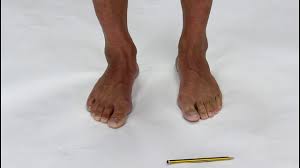
- A person may perform this stretch one foot at a time or with both feet together.
- Stat with Sit with the feet flat on the floor.
- Lift the toes, trying to get them all to the same height.
- Hold for 10 seconds.
- Lower the toes.
- Repeat 15 times on each foot.
Toe lift and spread
A person may perform this stretch one foot at a time or with both feet together. Place a rubber band around the toes to improve resistance and make it more difficult.
- Start with Sitting with the feet flat on the floor.
- Lift the toes, trying to get them all to the same height.
- When they are lifted, spread the toes as far apart as possible.
- Hold for 10 seconds.
- Relax the toes and lower them back down.
- Repeat 15 times on each foot.
Toe flex
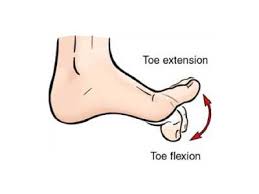
- Start with standing next to a hard upright surface like a wall with the feet shoulder-width apart.
- Using your hands to steady yourself, bend the toes of one of the feet as you press them against the wall. Hold for 10 seconds.
- Move the foot back so it is flat on the floor.
- Repeat 15 times on each foot.
Big toe pull
This stretch improves mobility and flexibility in the big toe. A person may also do it using their hands if a towel or belt is not available.
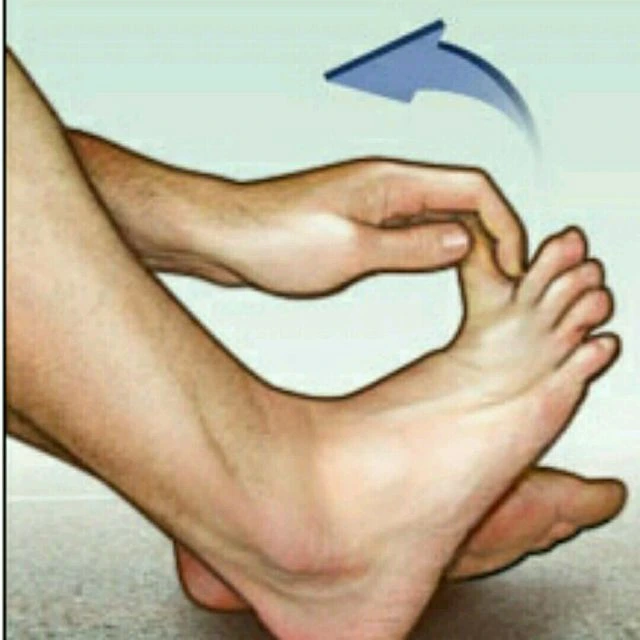
- Start with Sitting with the feet flat on the floor.
- Muffle a towel or belt around the big toe.
- Drag the towel or belt toward you while pushing against it with your foot. Hold for 15 seconds.
- Repeat 15 times on each foot.
Lateral toe stretch
This stretches the toes from side to side instead of up and down. A person may perform this stretch one foot at a time or with both feet together.
- Start with Sitting with the feet flat on the floor.
- Point the toes up.
- Move the toes to the left without moving the foot. Hold for 10 seconds.
- Relax the toes.
- Point the toes up.
- Move the toes to the right without moving the foot.
- Hold for 10 seconds.
- Relax the toes.
- Repeat the stretch with the toes pointed down.
- Repeat 10 times on each foot.
Toe raise, point, and curl
A person may perform this stretch one foot at a time or with both feet together.
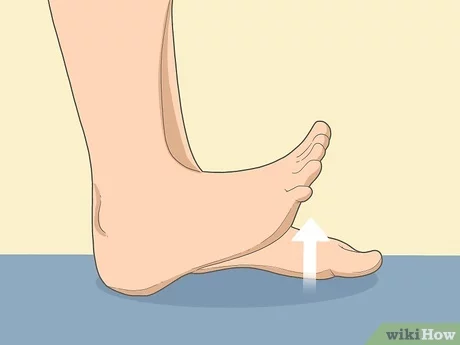
- Start with Sitting with the feet flat on the floor.
- Lift the front of the foot, leaving the heel on the floor.
- Raise the toes as high as possible. Hold for 10 seconds.
- Point the toes down. Hold for 10 seconds.
- Raise the heel and curl the toes under so the toenails or the tips of the toes are on the floor.
- Repeat 15 times on each foot.
Standing toe stretch
- Start with a Stand with the back against a wall.
- Cross the left leg over the right leg at the ankle.
- Point the toes of the left foot and push them against the floor so the toenails are against the floor.
- Hold for 10 seconds.
- Relax the toes.
- Repeat 15 times on each foot.
Stretches that increase strength
Toe splay
A person may perform this stretch one foot at a time or with both feet together. Place a rubber band around the toes to improve resistance and make it more difficult.
- Start with Sitting with the feet flat on the floor.
- Spread the toes apart as far as possible. Hold for 10 seconds.
- Relax the toes.
- Repeat 15 times on each foot.
Toe lift and press
This stretch increases the control over the motions as well as strengthens them.
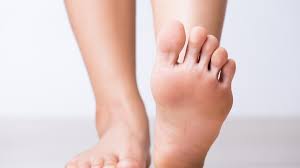
- Start with Sitting with the feet flat on the floor.
- Lift the toes on one foot or both feet at the same time, trying to lift them all to the same height.
- Press only the big toe down and up 5 times.
- Press only the little toe up and down 15 times.
- Alternate pressing the big toe up and down 1 time with pressing the little toe up and down 1 time.
- Repeat rotating big and little toes 10 times on each foot.
Doming
This stretch strengthens the toes and lifts (“domes”) the arch of the foot.
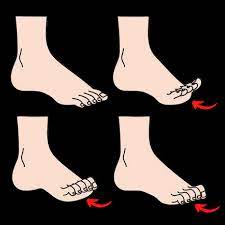
- Start with Sitting with the feet flat on the floor.
- Try to grip the floor with your toes.
- Make sure a person is using a grabbing motion and not just curling the toes.
- Hold for 10 seconds.
- Relax the toes.
- Repeat 10 times on each foot.
Toe curl
This stretch strengthens the toes. Sometimes it is also known as a “towel scrunch” for the action of gathering up the towel under the toes. Adding a weight to the towel enhances the difficulty.
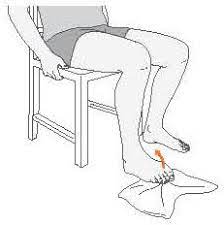
- Start with Sitting with the feet flat on the floor.
- Put a small towel on the floor with the short side facing you.
- Hold the towel with the toes on one foot and try to drag it toward you.
- Hold for 10 seconds.
- Relax the foot.
- Repeat 10 times with each foot.
Marble pick up

- Sit with your feet flat on the floor.
- Put two bowls on the floor in front of you, one empty and one holding 10 to 20 marbles.
- Carry each marble to the open bowl using the toes of one foot.
- Repeat with the other foot.
Walking in the sand
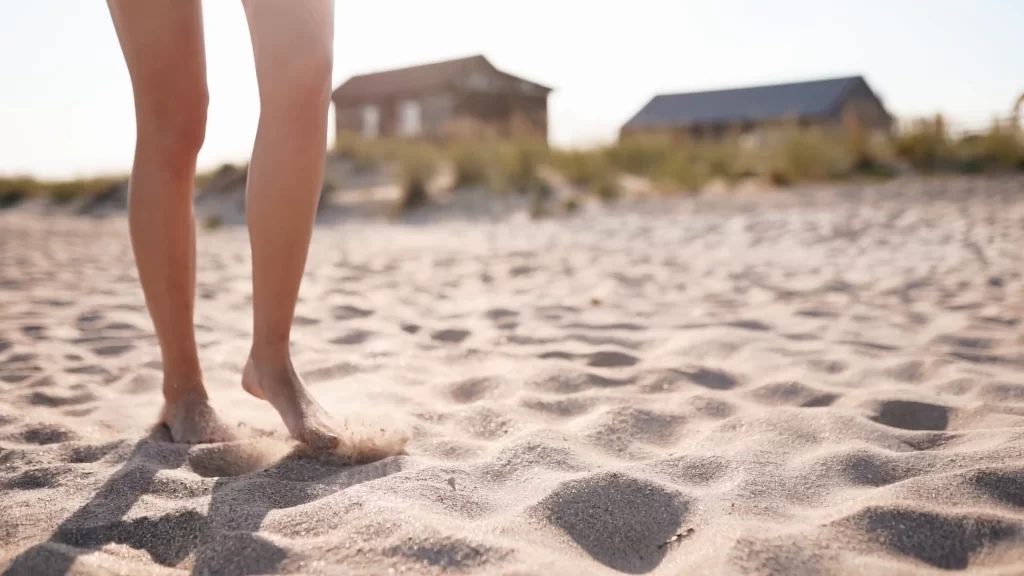
- This is useful for strengthening the toes, feet, and calves.
- It may be tiring, so perform it for 5 to 10 minutes at first, then improve the time as tolerated.
- Walk barefoot in a residence surrounded by sand, like a beach or sandbox.
Big toe stretch
This stretch is good if the toes have been squeezed from wearing tight or pointy shoes.
- Start with Sitting with the feet flat on the floor.
- Lift the right leg and place your ankle on the left thigh.
- Using the hands, move the toe up, down, and to each side, holding for 10 seconds in each position.
- Repeat 5 times.
- Change the legs and repeat on the big toe of the left foot.
Finger toe stretch
This stretch removes pressure on misaligned, painful toes.
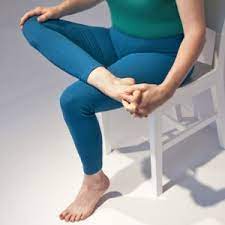
- Start Sitting with the feet flat on the floor.
- Lift the right leg and place the ankle on the left thigh.
- Intertwine the fingers of the right hand with the toes.
- Stretch the toes apart with the fingers as long as a person is able.
- Put the foot back on the floor.
- Repeat with the left leg.
Toe splay
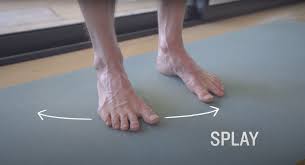
Doing the toe splay exercise may increase control over the toe muscles. Individuals may perform it on both feet at once or on alternate feet, depending on which they find more comfortable.
To do this exercise:
- Start with sitting in a straight-backed chair, with the feet gently resting on the floor.
- Extend the toes apart as far as possible without straining.
- Keep this position for 10 seconds.
- Repeat this motion 10 times.
- Once an individual has built up their strength, they may try looping a rubber band around the toes.
- This will supply resistance and make the exercise more challenging.
Surgery
Surgery can be suggested if conservative methods do not help to reduce the pain or straighten the toes. Surgery can also be the go-to option to correct:
A severely overlapping tiny toe
A big toe with a bunion
Complications of overlapping toes
Symptoms can develop gradually and can be aggravated if other foot problems are included. It is good to see a physician early on to prevent the symptoms from getting worse and to find the right kind of treatment to help align the toes correctly.
Common complications
Pain- The toe can rub against the shoe, making it uncomfortable to walk. This may cause the gait to change, which in turn might affect the legs and other muscles.
Corns -Corn is a small, hard bump that forms on the tops or sides of the toe. It may be sensitive to touch and painful when wearing shoes.
Calluses- The thickened skin patches form on the bottom or side of the foot. They are similar to corn but are generally larger and less painful. Calluses are caused by repeated excess pressure on the skin of the feet.
Bursitis- This condition is caused by inflammation of the fluid-filled sacs that surround the joints. Shoes that rub against an overlapping toe can cause bursitis in the toe joint.
Metatarsalgia– This is a painful condition where the ball of the foot becomes inflamed. It can be connected with bunions, high arches, hammer toe, or a long 2nd toe.
FAQ
Crossover toe is a condition distinguished by a 2nd toe that drifts towards the big toe and eventually can lead to the toe crossing over and resting on top of the big toe. It is a progressive condition that may develop at any age, but it is most common in adults.
Crossover toe is a standard foot problem that may inhibit physical activity for active adults, but conservative treatment may slow down the progressive malformation, or outpatient surgery can correct the malformation and keep people active and on their feet.
Crossover toe is a common condition that may appear at any age, although most often in adults. Some individuals confuse a crossover toe with a hammertoe, presumably because both conditions involve a toe that does not lie in the normal position.
Crossover toes & possible complications
Genetics plays a big role in how our feet move and look. If the parents have a toe that crosses over another, you can be more predisposed to developing one at some point in your life.
big toe
It assumably is no surprise that the big toe is the most significant when maintaining balance and bearing body weight. The big toes bear just about 2 times the amount of weight as all the other toes combined! It still should not shock a person that the pinky toes are the least important.
References
Hecht, M. (2019, October 23). Causes and Treatment of Overlapping Toes in Adults and Newborns. Healthline. https://www.healthline.com/health/the-causes-of-overlapping-toes-and-treatment-options#treatment-for-newborns
Coughlin, M. J. (1987, August 1). Crossover Second Toe Deformity. Foot & Ankle; SAGE Publishing. https://doi.org/10.1177/107110078700800108
Orthopedics, E. (2015, May 8). Crossover Toe | Treatment & Surgery | Extend Orthopedics. Extend Orthopedics. https://www.extendorthopedics.com/conditions-and-treatments/toe/crossover-toe/
Toe. (2023, August 15). Wikipedia. https://en.wikipedia.org/wiki/Toe
Cadman, B. (2023, April 12). What are the best foot exercises for healthy feet? https://www.medicalnewstoday.com/articles/320964#foot-health-and-safety-tips

